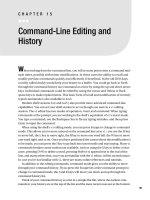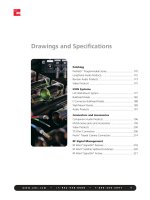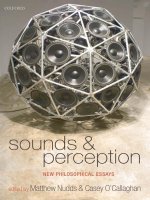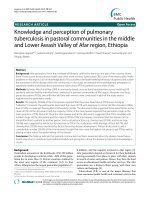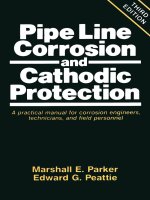Line drawings and perception
Bạn đang xem bản rút gọn của tài liệu. Xem và tải ngay bản đầy đủ của tài liệu tại đây (2.15 MB, 41 trang )
Part
Part III:
III:
Line
Line Drawings
Drawings and
and Perception
Perception
Doug
Doug DeCarlo
DeCarlo
Line
Line Drawings
Drawings from
from 3D
3D Models
Models
SIGGRAPH
2005
Course
SIGGRAPH 2005 Course Notes
Notes
1
Line drawings
crosscross-hatching
hatching
contour
crease
Albrecht Dürer,
Dürer, “The Presentation in the Temple”
from Life of the Virgin (woodcut, circa 1505)
Line drawings bring together an abundance of lines to yield a
depiction of a scene. This print by Dürer employs different types of
lines that convey geometry and shading in a way that is compatible
with our visual perception. We appear to interpret this scene
accurately, and with little effort.
Some of the lines here, such as contours and creases, reveal only
geometry. The fullness of this drawing comes from Dürer’s use of
hatching and cross-hatching. These patterns of lines convey shading
through their local density and convey geometry through their
direction.
2
Line drawings
John Flaxman,
Flaxman, “Venus Disguised Inviting Helen to the Chamber of Paris”
(illustration for The Iliad,
Iliad, etching, 1805)
Other drawings rely on little or no shading, such as this one by
Flaxman. Here, the use of shading is limited to the cast shadows on
the floor. The detail in the cloth is conveyed with lines such as
contours and creases, and perhaps other lines such as suggestive
contours, ridges and valleys. While artists can produce drawings
like this, they don’t have access to the nature of the processes
behind what they’re doing. They rely on their training, and use their
own perception to judge the effects of their decisions.
3
Ambiguity of lines in images
The ambiguity of projection
• an infinity of 3D curves can project to the same
line in the image
It’s actually a bit surprising that line drawings are effective at all.
Upon first inspection, line drawings seem to be too ambiguous. An
infinity of curves in 3D project to the same line in the image. All
images have this ambiguity, but in photographs there are many other
cues such as shading that help to indicate shape. Here we are
looking just at individual lines.
But it turns out that individual lines contain a wealth of information
about shape. This information is typically local in nature; our
perception is somehow able to integrate all of this into a coherent
whole. Well, sort of.
4
Impossible line drawings
The Penrose triangle (1958)
Victor Vasarely,
Vasarely, XICO (silkscreen, 1973)
Line drawings of impossible 3D objects show us that this coherence
is not global. The Penrose triangle, inspired by the work of M.C.
Escher, is perhaps the simplest of the impossible figures. At first, it
appears like an ordinary object. Closer inspection is a bit unsettling,
and its inconsistencies are easily revealed, producing an nonconvergent series of visual inferences (which can be quite fun to
explore). Artists such as Vasarely have pushed this idea even
further, producing vivid imagery that encourages us to explore
several different inconsistent interpretations simultaneously.
5
Interactions between lines
• Interpretation of line drawings depends on
context
after [Barrow 1981]
Although you might think the Penrose triangle shows that there are
no global effects for visual inference, it’s not that simple. The
figure on the left appears to be raised in the center, while the figure
on the right is flat on the top and bends along its length. Only the
line along the bottom of the drawing differs. Nobody knows
whether we perceive this difference because we integrate local
information consistently, or perform certain types of non-local
inference.
6
Interpretation of line drawings
Labeling of polyhedral scenes
• use an exhaustive catalog of
possible labels of junctions
• determine configurations of
consistent labels using
constraint satisfaction
[Waltz 1975]
L
Fork
T
Arrow
adapted from [Waltz 1975]
Use of non-local inference is plausible; algorithms exist for
searching among the space of possibilities. Waltz’s method linelabeling starts with catalogs of all possible line junctions—places
where two or more lines meet. Shown here is the catalog of 18
junctions for classifying trihedral vertices in polyhedral scenes,
where lines are labeled as convex (+), concave (-), or on a boundary
(inside is to the right of the arrow). Then, methods for constraint
satisfaction produce the set of all possible configurations for a
particular picture. For an impossible figure, this set is empty.
7
Interpretation of line drawings
Labeling for more general scenes
• use larger catalogs of junctions
• rely upon methods to prune unreasonable or
unlikely configurations
[Barrow 1981, Malik 1987]
after [Malik
[Malik 1987]
Methods for interpreting line drawings that contain smooth surfaces
extend the junction catalogs and rely upon methods that prune away
large numbers of unreasonable interpretations.
All of these methods label lines with a type; they don’t infer
geometry. Furthermore, they are restricted to lines from contours
and creases, and occasionally lines from shadows.
8
Interpretation of line drawings
A range of algorithms exist for interpreting
certain types of line drawings
Not very much is known about how humans
process line drawings
However, a lot is known about what
information people could be using for
interpretation
While these algorithms suggest that exhaustive search may be a
viable method for scene interpretation, they don’t say anything
directly about how people interpret line drawings. In fact, not very
much is known about that. Even so, we can still be very specific
about what information is available in a line drawing. This is the
information that our perceptual systems are probably using.
9
Interpretation of line drawings
Each line in a line drawing constrains the
depicted shape
• The nature of the constraint depends on the
type of line
• The type of the line can sometimes be
inferred from context (within the drawing)
Ambiguity always remains, although some
interpretations are more likely than others
Essentially, each line in a drawing places a constraint on the
depicted shape. In the discussion that follows, we will examine the
information that different types of lines provide. In the end, the
answer is never unique. However, our perceptual systems excel at
discovering the most likely interpretations.
10
Information in line drawings
Lines can mark fixed locations on the shape
–
–
–
–
creases (sharp folds)
ridges and valleys
surface markings (texture features, material boundaries, …)
hatching lines (although density is lighting-dependent)
Lines can mark view-dependent locations on the shape
– contours (external and internal silhouettes)
– suggestive contours
Lines can mark lighting-dependent locations on the shape
– isophotes (boundaries of attached shadows or in cartoon shading)
– boundaries of cast shadows
First, we’ll consider lines that mark fixed locations on a shape. This
includes creases, ridges and valleys, and surface markings.
Then, we’ll consider view-dependent lines. The most important is
the contour, which lets us infer surprisingly rich information about
the shape.
There are also lines whose locations are lighting-dependent, such as
edges of shadows; these won’t be discussed here.
Of these, only creases and contours are well understood. Research
on the information other types of lines provide is ongoing.
11
Information in creases
Creases mark discontinuities in surface orientation
– creases are either convex or concave
(this cannot be determined using only local
information)
– there is often a luminance discontinuity in shaded
imagery
concave
crease
convex
crease
Creases mark orientation discontinuities, and are typically visible in
a real image as a discontinuity in tone.
The crease can be concave or convex; local information doesn’t let
us determine which—algorithms for line labeling only proceeded by
considering all the possibilities, and then enforcing non-local
consistency.
12
Information in ridges and valleys
Ridge and valley lines mark locally rapid changes
in surface orientation
– one possible extension of creases to smooth surfaces
– like creases, they cannot be distinguished using only
local information
Ridges and valleys mark locally maximal changes in surface
orientation. They are often visible in real images as sudden (but
smooth) changes in tone.
The ridges on this rounded cube are particularly effective in
conveying its shape.
13
Information in ridges and valleys
Their use is still unresolved
– many ridges and valleys seem to successfully convey shape
– others seem to convey surface markings (inappropriately)
– viewers can locate them in shaded imagery [Phillips 2003]
contours
with ridges
with valleys
with both
Research on the use of ridges and valleys in line drawings is
ongoing. When used alongside contours, ridges and valleys can
often produce an effective rendering of a shape; the valleys on the
side of the horse are successful. In other cases, they look like
markings on the surface of the shape, such as the ridges on its head.
They are reasonable candidates for line drawings, as there is
psychological evidence that viewers can reliable locate ridges and
valleys in shaded imagery.
14
Information in surface markings
Can be located arbitrarily
– but seem to convey shape when they lie along
geodesics (locally shortest paths on the surface)
[Stevens 1981, Knill 1992]
– related to perception of texture
[Knill 2001]
along geodesics
not along geodesics
Markings on a surface can appear as arbitrary lines inside the shape.
However, for a certain type of line known as a geodesic, they can
also convey shape. (Geodesics are lines on the surface that are
locally shortest paths.)
Stevens points out that for many fabricated objects, surface
markings are commonly along geodesics. For a more general class
of surfaces, Knill draws connections between texture patterns and
sets of parallel geodesics.
15
Information in surface markings
Parallel lines in space can also convey shape
– building correspondences between adjacent lines
(using tangents of the curves) lets the viewer infer
the shape
[Stevens 1981]
When used in repeating patterns, other curves can be effective as
well. Sets of parallel lines, which are often used to construct plots
of 3D functions, are one notable example. The images that result
are analogous to using a periodic solid texture. Stevens points out
that all one needs to do to infer the shape is to build
correspondences between adjacent lines, matching up points with
equal tangent vectors.
16
Information in hatching
Conveys shape through direction of hatching lines
– more effective when drawn along geodesics
[Stevens 1981, Knill 2001]
– lines of curvature are particularly effective
[Girshick 2000, Hertzmann 2000]
along geodesics
along lines of curvature
[Hertzmann 2000]
The use of repeating patterns of lines forms the basis of hatching.
These lines convey shape in two different ways; they convey shape
directly when they are drawing along geodesics. And they convey
shape indirectly through careful control of their density, which can
be used to produce a gradation of tone across the surface.
Particularly effective renderings are obtained when lines of
curvatures are used, which are lines that align with the principal
curvature directions, and also happen to be geodesics. To convey
tone, these lines are used in careful combinations that control their
density in the image.
This concludes the discussion on lines whose locations are fixed on
the shape.
17
Information in contours
For contours, there are two possible situations:
• It comes from a smooth part of the shape
– Normal vectors on the surface along the line lie
perpendicular to the viewing direction
• It comes from a crease (or other discontinuity)
Next comes lines whose location on the shape depends on the
viewpoint.
The contours are the most notable example of such lines. There are
two situations when contours are formed. On a smooth surface,
contours are produced when the surface is viewed edge-on. On an
arbitrary surface, contours can also be produced along a crease.
18
Information in contours
The contour generator is the curve sitting on the
surface that projects to the occluding contour
contour
contour generator
In either case, sitting on the surface is a 3D curve known as the
contour generator. This curve marks all local changes in visibility
across the shape. For a generic (non-singular) viewpoint, the
contour generator consists of a set of isolated loops.
The contour generator projects into the image to become the
contour. Not all parts of the contour are visible.
19
Visibility of contours
Not all parts of the contour generator are visible
• First case: “non-local” occlusions
– Visibility changes occur at T-junctions
– where the viewing direction grazes the surface at
two separated locations (forming a bitangent)
Let’s consider the different cases of visibility for contours.
On a smooth surface, the first case is when one part of the shape
occludes another more distant part. This appears in the image as a
T-junction, where the contour goes behind another part of the shape.
At the location where the visibility changes, the visual ray is tangent
to the surface in two places.
20
Visibility of contours
Not all parts of the contour generator are visible
• First case: “non-local” occlusions
– The contour continues in back
– and is simply occluded
The contour then continues behind the shape, and is occluded. It is
seen here in this transparent line-drawing of a torus.
21
Visibility of contours
Not all parts of the contour generator are visible
• Second case: ending contours
– the visible part of the contour ends
– at a cusp in the projection of the contour generator
The second case occurs where the contour comes to an end in the
image. When the occluded part of the contour continues, it does so
at a cusp in the contour.
22
Visibility of contours
Not all parts of the contour generator are visible
• Second case: ending contours
– the tangent of the contour generator lines up with
the viewing direction at this point
This cusp occurs because the contour generator lines up with the
viewing direction, so that its tangent projects to a point.
23
Visibility of contours
Not all parts of the contour generator are visible
• Second case: ending contours
– the radial curvature is zero (the viewing direction
is an asymptotic direction of the surface)
At an ending contour, the radial curvature is zero, which means that
we’re looking along an inflection—an asymptotic direction of the
surface.
24
Visibility of contours
Not all parts of the contour generator are visible
• Third case: local occlusions (“inside contours”)
– these parts of the contour generator are never
visible; the surface always blocks them
– the radial curvature is negative
The last case is a local occlusion; places where the surface has no
choice but to occlude itself.
These are locations where the radial curvature is negative.
25
